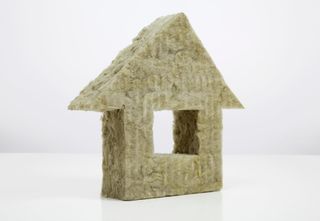How to install cavity wall insulation correctly and avoid expensive mistakes
Our expert guide to installing cavity wall insulation will help you keep your home warm and avoid the astronomical expenses that can result from getting it wrong

If you’re a self-builder, knowing how to install cavity wall insulation (CWI) is crucial to keeping your home warm and energy efficient.
Cavity wall insulation problems can be costly to fix and will negatively affect your home's efficiency — so it's also important to get it right from the outset of your build wheninsulating a wall.
Below, Tim Pullen shares his best practice guide to getting the job done. As an expert in sustainable building methods, he explains how to install cavity wall insulation correctly, as well as how much insulation you will need, and the costs involved.
How to install cavity wall insulation
There is a strong argument that a cavity wall without insulation is only half a wall. The function of a wall is to keep the weather out, which does not just mean the rain, but heat as well. An increasingly important function of a wall is to keep the heat on the right side: inside in winter and outside in summer. Which means installing insulation, and in the right way to avoidcavity wall insulation problems.
Getting cavity wall insulation wrong can be a disaster and expensive – as the sheer position of being inside a wall can make it very difficult to access. But there are only two fundamental issues to getting this process right:
1. Use the right amount andtypes of insulation. The majority of expense is in the work involved in installing it, not in the material itself.
2. correct installation. Install it with the same care and attention to detail that would be lavished on fitting out a kitchen. Bad installation is where problems will occur – be that damp penetration or loss of thermal efficiency.
How much insulation will you need?
The current requirement is to achieve aU value of not more than 0.18W/m2. But it’s quite possible that this will soon drop to 0.15W/m2 and given the cost of energy and the whole CO2 issue, it would be wise to aim for that lower figure. However, even a U value of 0.18W/m2 figure will need 100mm of rigid foam insulation (Xtratherm, Celotex CW4000 or similar) or 170mm of mineral wool.
1) Cavity wall insulation in masonry walls

Self-builders need to install 100mm of insulation and completely fill the cavity to maximise thermal performance and minimise the wall thickness. Completely filling the cavity means that using best practice on site is essential to a well-insulated and watertight wall. The key areas to address are:
- Mortar joints – perps and horizontal – for both skins must be solidly filled with mortar without gaps.
- Mortar droppings must be removed from cavity ties and the bottom of the cavity kept free of droppings.
- Excess mortar must be removed flush from both inner and outer skins.
- Each row of insulation boards should be supported with at least two wall ties.
- The insulation must be in tight, in flush contact with the inner leaf of the wall.
- There must be no gaps between insulation boards. If necessary, joints should be taped to ensure gaps are closed.
- With fully filled insulation, the boards need to be foil-faced to prevent moisture penetration
- Cuts to insulation boards to accept wall ties should be avoided as much as possible and where cuts are made, the gap should be filled with insulation off-cuts
- Cavity closers must themselves be insulated and insulation boards fitted flush.
To achieve the best results, it's crucial to start with high-quality insulation that's free from damage and store it correctly on-site. Insulation boards that get wet or damaged won't work effectively. One challenge is that insulation is typically added to the wall cavity during construction, which can expose it to moisture overnight. It's important to ensure the top of the wall is well weatherproofed as construction progresses to maintain insulation performance.
When using wall ties, plastic ones are ideal for preventing heat loss, but if not available, some bricklayers may opt for steel ties, which should not penetrate the inner wall by more than 25mm.
2) Cavity wall insulation for timber-frame walls

When dealing with timber frame walls, you don't have to worry about fitting insulation tightly to an inner layer because the timber frame serves as that layer. However, choosing the right insulation type and thickness can be a challenge. Typically, to achieve a U-value of 0.18W/m2, you'll need 140mm of rigid foam insulation, which is a standard stud thickness for timber frame construction. Thicker walls are possible but tend to be customised, especially if you're using flexible or semi-rigid insulation materials like Rockwool, wood fiber, hemp, or sheep wool.
The main issue with rigid insulation is that it's harder to install precisely because it needs to be cut to size, often leading to small gaps between the insulation and timber studs, reducing thermal performance. Semi-rigid insulation is a solution since it's cut slightly larger to ensure a snug fit, eliminating gaps and slumping, a problem that can occur with flexible insulation.
Achieving a target U value of 0.18W/m2 may require 190mm of semi-rigid insulation, which exceeds the standard timber frame thickness. One approach is to install 140mm of semi-rigid insulation within the stud wall and add another 50mm layer of rigid insulation on the outside of the timber frame (using rigid foam or wood fiber) with a brick, timber, or render weatherproof outer layer. This combination meets the U-value requirement and offers excellent thermal efficiency.
How do I avoid thermal bridges?

A thermal bridge is a weak spot in the insulation. Essentially, it’s where a line can be drawn from the inside to the outside of a building without passing through a full thickness of insulation — or where there are gaps in the insulation. It’s also where highly conductive materials (steel wall ties, steel lintels, etc) penetrate from the inside of the house to the outer leaf. You can read our handywhat is a thermal bridgeguide for more information about this.
The Building Research Establishment(BRE) have stated that even a well-insulated house’s thermal bridges can account for 30% of heat loss. Such a problem can be solved with good design and attention to detail during construction and ensuring that insulation in the floor, walls and loft overlap sufficiently.
How do I retrofit cavity wall insulation?

Internal wall insulationin a renovation can be tricky because different projects vary. However, in all instances the first step is to determine if your walls have a cavity and whether there's any existing insulation.
If your house was built after 1920, it's likely to have a cavity, but it's best to consult a reputable installer who can use a borescope to inspect the wall. They will drill a small hole in the outer layer, insert a tiny camera, and visually assess the cavity's condition (if present). This inspection also checks for any debris, like mortar droppings on cavity ties, and confirms if there's existing insulation.
If your wall has a clean and empty cavity, you can proceed with injected insulation, which performs similarly to rigid foam. The use of injected insulation is dependent on the width of the cavity – likely to be 50mm – but it’s better than nothing.
Consider using a thermal imaging camera to ensure the insulation fills the entire cavity properly. In some cases, like my own experience, incomplete insulation may not become apparent until later, leading to issues like black mould forming around windows two years down the line.
岛叶空心墙要多少钱tion costs?
With a new build there is no cost to insulating a wall, at least no extra cost, as insulation must be installed to comply with Building Regulations. But when it comes tohow to insulate an old homethe costs can vary depending on the project.
The Energy Saving Trusttells us that injecting insulation to an existing wall is likely to cost £1800 to £2500 for a detached houseand £1000 to £1500 for a semi-detached. Energy savings will then be in the order of £500-£600 per year for the detached house and £300-£400 for the semi-detached.
Get the Homebuilding & Renovating Newsletter
Bring your dream home to life with expert advice, how-to guides and design inspiration, direct to your inbox.
Tim is an expert in sustainable building methods and energy efficiency in residential homes and writes on the subject for magazines and national newspapers. He is the author of可持续建筑的圣经,Simply Sustainable Homes and Anaerobic Digestion - Making Biogas - Making Energy: The Earthscan Expert Guide.
His interest in renewable energy and sustainability was first inspired by visits to the Royal Festival Hall heat pump and the Edmonton heat-from-waste projects. In 1979
this initial burst of enthusiasm lead to him trying (and failing) to build a biogas digester to convert pig manure into fuel, at a Kent oast-house, his first conversion project.
Moving in 2002 to a small-holding in South Wales, providing as it did access to a wider range of natural resources, fanned his enthusiasm for sustainability. He went on to install renewable technology at the property, including biomass boiler and wind turbine.
He formally ran energy efficiency consultancy WeatherWorks and was a speaker and expert at the Homebuilding & Renovating Shows across the country.
- Gabriella DysonAssistant Editor
Bring your dream home to life with expert advice, how-to guides and design inspiration, direct to your inbox.
Thank you for signing up to Homebuilding. You will receive a verification email shortly.
There was a problem. Please refresh the page and try again.

